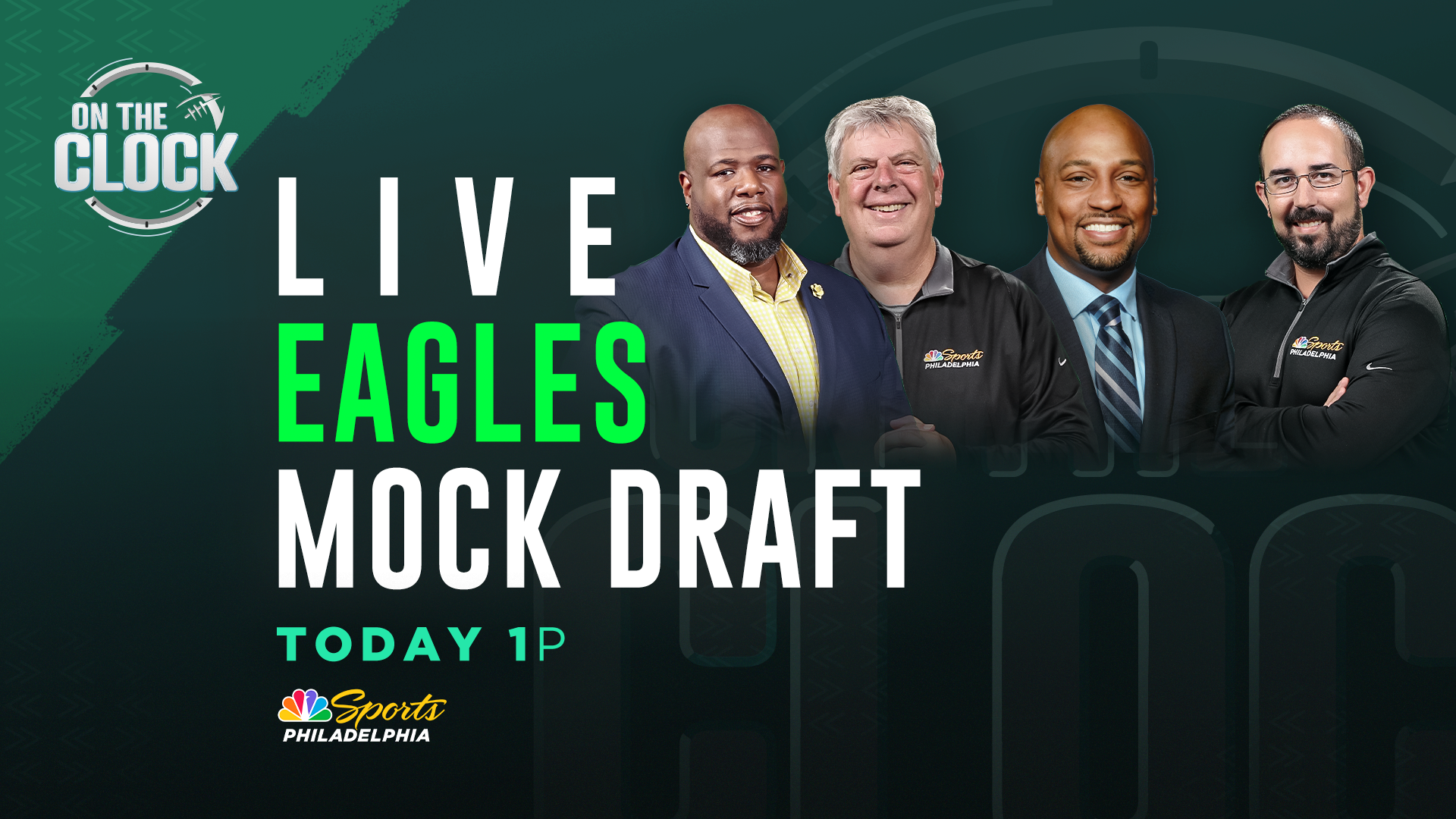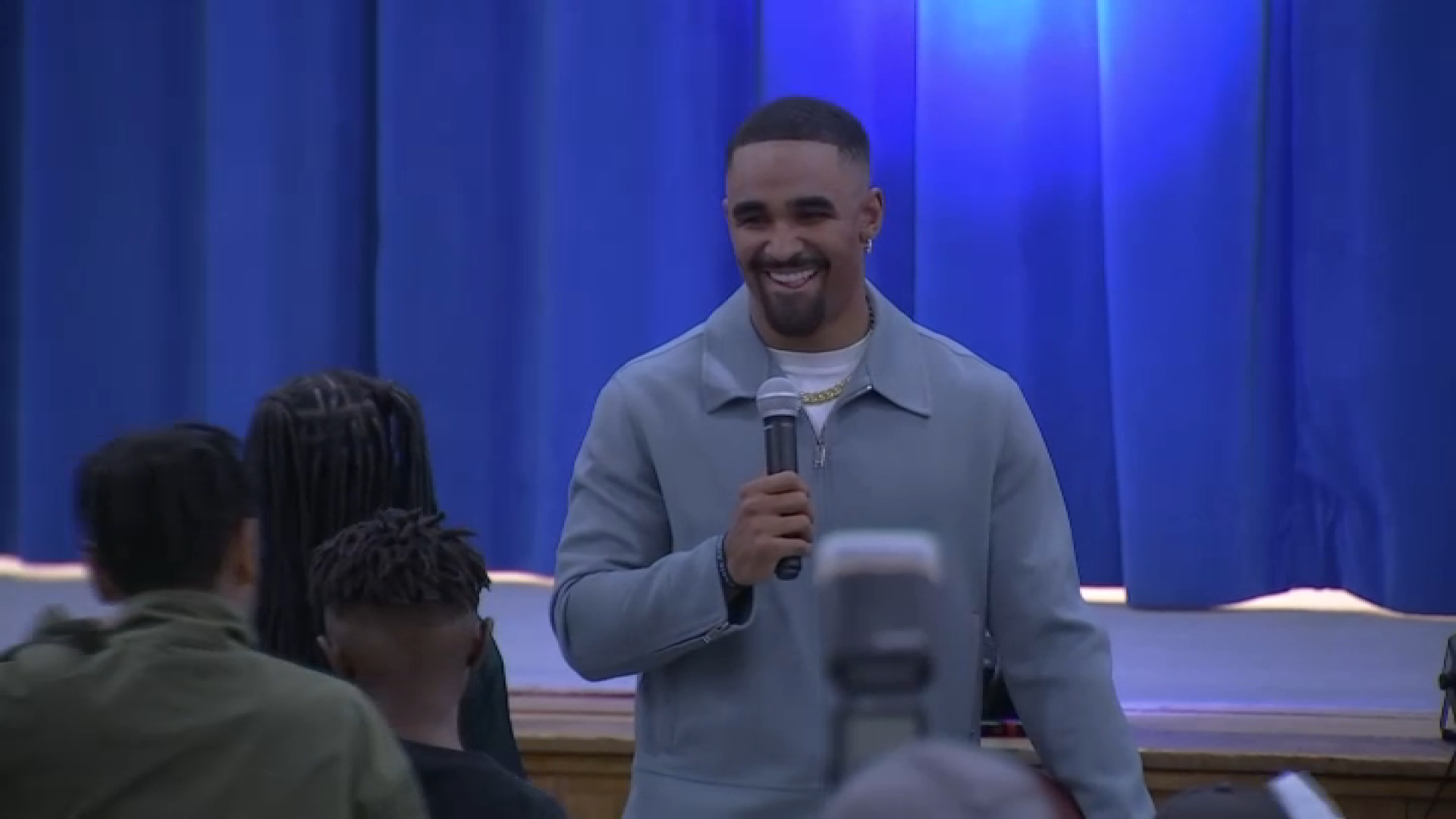Howie Roseman’s secret to building the offensive line, expectations for Sydney Brown and a look at the Eagles’ running back room.
With a dazzling draft in our rearview mirror and the always-exciting schedule release rapidly approaching, here’s this week’s 10 random Eagles offseason observations. With a heavy dose of draft observations.
1. When it comes to roster building, Roseman approaches the offensive line differently than every other position. The Eagles generally have a mix of draft picks and outside veterans at most positions. Some of their best players have been free agents or trade acquisitions — from A.J. Brown to Javon Hargrave to Chauncey Gardner-Johnson to Darius Slay and James Bradberry. You can pop a linebacker or running back or pass rusher or receiver into the lineup for a year and he’ll be fine.
Stay in the game with the latest updates on your beloved Philadelphia sports teams! Sign up here for our All Access Daily newsletter.
But the O-line is different. There’s no position on the football field where continuity, chemistry and communication are more important than the offensive line. So if you can build with homegrown players who have a long-term commitment to this organization that’s huge.
Since he signed Brandon Brooks and Stefen Wisniewski in 2016, Roseman has built the offensive line entirely with draft picks or homegrown undrafted rookies. Over the past three seasons, homegrown players have started 237 of a possible 250 games on the offensive line. The only exceptions are Jason Peters (eight starts in 2000), Brooks (two starts in 2001) and Jack Anderson, Jamon Brown and Le’Raven Clark (one start each).
It's also easier for Jeff Stoutland to teach players his philosophy and technique if they haven’t already played for other NFL teams.
Look at the Eagles’ offensive line heading into 2023: Jason Kelce is going into his 13th year here, Lane Johnson his 11th year, Jordan Mailata is now in his sixth season. Landon Dickerson isn’t going anywhere, and Cam Jurgens and Tyler Steen are in for the long haul.
NFL
The more O-linemen can practice and play together, the stronger the entire unit is, and the best way to create that continuity is by drafting guys and letting them all grow together. You can slap together an offensive line and be OK. But if you want one of the best O-lines in the NFL year after year, it makes sense to do it Howie’s way.
2. The Eagles have drafted 13 players in the first, second or third round since 2020 and eight of them played at Georgia or Alabama.
3. I’d expect Brown to get every opportunity to win a starting job in camp this summer. Reed Blankenship and Terrell Edmunds will probably get the first shot at safety, but Edmunds is on a one-year deal and the Eagles have no commitment to him beyond this year. Ideally, the Eagles would want Blankenship and Brown to start at safety. Edmunds is an experienced veteran and has started 75 games over the last five years, but he’s on a one-year deal and the Eagles are always going to give opportunities to young guys on long contracts who are going to be here for years.
If Blankenship and Brown start together this year it’s a step toward the future. Edmunds probably won’t even be here next year. Heck, if he’s not starting, he might not be here at all. The Eagles haven’t hesitated in the past to release veterans if they lose their starting job: Anthony Harris, Corey Nelson, Zach Brown. Edmunds would only count $600,000 against the cap if they do release him. We’re getting a little ahead of ourselves, but I’d expect Brown to get some first-team reps at camp. And if it goes well? He’s the guy.
4. How crazy is drafting three players from Georgia in the first round in a two-year span? There are only six other schools that have produced three Eagles first-round picks in the 88-year history of the draft: Five from USC and three each from Arkansas, Florida State, Michigan State, Notre Dame and Oklahoma.
5. Jalen Hurts already has three career games with three rushing touchdowns. The only other quarterback in NFL history with three games with three career rushing TDs is Orban Eugene “Spec” Sanders, who had all three in his 1947 all-pro season for the New York Yankees of the All-American Football League (whose stats were absorbed by the NFL when the leagues merged in 1949).
Only three other QBs even had two such games: Johnny Lujack of the Bears in 1950 and 1951, Tobin Rote of the Packers in 1954 and 1956 and the Vikings’ Daunte Culpepper in 2000 and 2007. Only 13 others have had one.
6. Was trying to think of the last really bad player the Eagles drafted out of the SEC with a Day 1 or 2 pick. Derek Barnett has been disappointing but at least he’s a functional player and had a significant role on a Super Bowl championship team. Bennie Logan wasn’t great but he was a four-year starter. Reggie Brown’s career withered away pretty quickly, but he actually averaged 50 catches, 722 yards and 5½ touchdowns his first three seasons. Shawn Andrews’ career ended prematurely, but he was a two-time Pro Bowler and an all-pro before his career was derailed.
I think you have to go back to linebacker Quinton Caver, the Eagles’ second-round pick and No. 55 overall out of Arkansas in 2001. He played in only 16 games over two years for the Eagles with no starts before brief stints with the Chiefs and Cowboys and was out of the league at 27. No wonder Howie keeps drafting SEC guys.
7. I was looking at Matt Miller’s final seven-round mock draft on ESPN.com and he had Jalen Carter going fifth overall to the Seahawks, Nolan Smith eighth to the Falcons and Kelee Ringo 32nd with the first pick in the second round. Now, this is all subjective and all projections were different, but most of them were along those same lines.
How did it play out?
The Eagles got them ninth, 30th and 105th. You never know what’s going to happen with draft picks, but the value the Eagles got with these three Georgia stars is remarkable. If any of them don’t work out, it’s not because the process was flawed.
8. Brown is only the third defensive back Roseman has drafted in the first three rounds in his last 11 drafts. The other two were corners in 2017 — Sidney Jones at No. 43 in the second round and Rasul Douglas later in the day in the third round at No. 99.
Brown is the first safety the Eagles have drafted in the first three rounds since Temple’s Jaiquawn Jarrett in the second round in 2011. He’s only the fourth safety the Eagles have drafted in the first three rounds since Brian Dawkins in 1996. The others were Michael Lewis in the second round in 2002 and Nate Allen in the second round in 2010.
9. Tanner McKee is the 22nd quarterback the Eagles have drafted in the fifth round or later. The first 21 won a total of seven games for the Eagles. Koy Detmer went 3-5 and A.J. Feeley 4-3. None of the others ever threw a pass in an Eagles uniform although three of them played for other teams, notably Bob Berry, the Eagles’ 11th-round pick in 1964. Berry went 20-29-3 for the Vikings and Falcons.
The two others are 1959 25th-round pick Dick Jamieson, who won his only start in 1960 for the New York Titans, and 1992 fifth-round pick Craig Erickson, who went 14-21 for the Buccaneers, Colts and Dolphins.
10. Kenny Gainwell, Rashaad Penny and Boston Scott are all super talented. No argument there. Gainwell supplanted Miles Sanders as the Eagles’ RB1 down the stretch and in the postseason, Penny is tied with Hall of Famer Marion Motley with the highest career rushing average by a running back. Scott has the fourth-fewest carries ever by a running back with 19 or more touchdowns.
But as talented as they all are, all also carry big question marks. Gainwell has had three career games with 50 rushing yards. Penny has averaged 67 carries per season. Scott has had more than 10 carries nine times in five seasons.
That’s why D’Andre Swift makes sense. Maybe the Eagles could have gotten by with Penny, Gainwell and Scott. But none of them has ever been a bell-cow back. Swift is probably only a one-year rental, but while the Eagles learn whether Penny can stay healthy and whether Gainwell can handle an increased workload, you have a guy who’s averaged 959 scrimmage yards in his three seasons, just turned 24 and costs under $2 million.
I like Gainwell. I like Penny. I like Scott. But I also like having another weapon for Hurts, a proven commodity at running back, a dual-threat, one of only five backs with 1,500 rushing yards and 150 catches over the last three seasons. More weapons is never a bad thing.
Subscribe to the Eagle Eye podcast
Apple Podcasts | Google Play | Spotify | Stitcher | Art19 | Watch on YouTube


